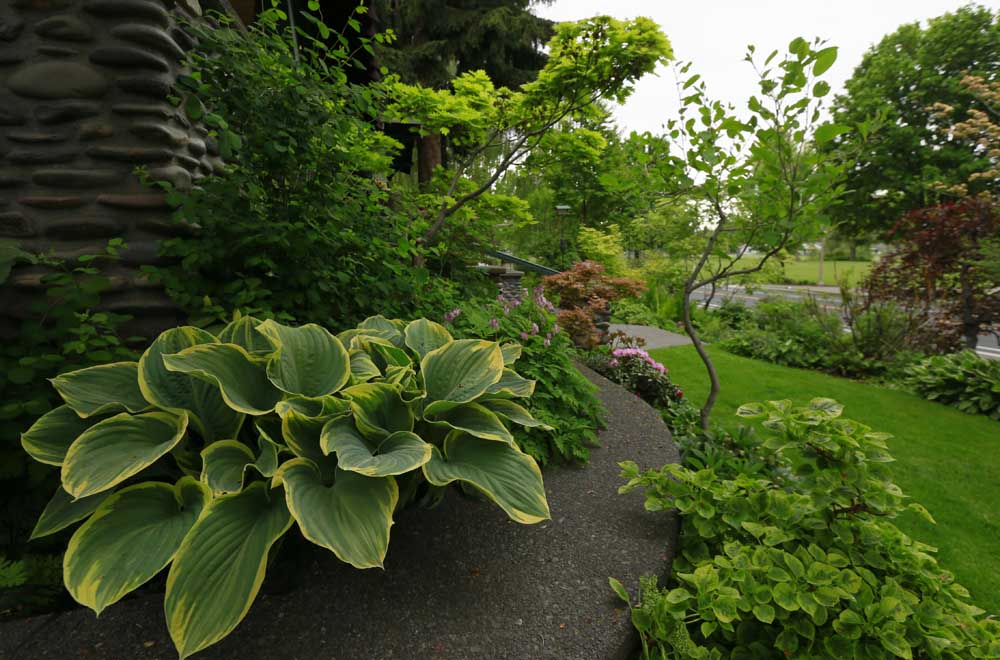Save up, then buy garden plants wisely
Published 12:00 am Tuesday, May 19, 2015

- Joe Kline / The Bulletin file photoHostas, bleeding hearts, a Japanese maple and a climing hydrangea grow in Bend.
Saving money for some of the extras of life is a challenge. I might have found a partial answer. That is, if you are patient. It involves a relationship between those sales receipts that tell you how much money you’ve saved and a pretty blue tin box. And you have to take an annual pledge not to dip into the tin box.
You can bump and thump your chest all you want for making all your smart purchasing decisions, but the challenge comes in actually, physically putting those dollars, or even those few cents, into a pretty container labeled “Plant Money.” You don’t dip into the container for espresso money, replacing money with IOUs. I tried that once and am red-faced to admit the IOUs were never replaced with cash. I can almost guarantee that from one growing season to the next, you will amass close to $100, if not more, if you save this way. Not sure how you would manage if you always pay with debit cards or the new fancy smartwatches. I suppose you could set up a virtual piggy bank, but then you would miss out on physically counting your loot.
I’m about ready to count out my booty, and because it has been acquired with diligence, I will spend it with care.
Advertising agencies have done a good job of convincing us that bigger is better, but that principle doesn’t always apply to buying plants. I know in our relatively short season we want instant gratification.
Bud over bloom
Our instinct is to always grab the plant in bloom. It is more prudent to choose bud over bloom. Most importantly, that goes for our coveted and long-awaited tomato plants. A tomato plant with a ripening tomato and a half-dozen blooms beneath it has three strikes against it when moved to your garden.
The tomato plant has been raised in an ideal setting of controlled temperatures and probably regular feedings. Now you are taking it home and expecting it to adjust to lower soil temperatures, grow new roots, continue to develop new buds and ripen the one tomato that is on the vine — all at the same time. A tomato plant knows nothing about multitasking. Be brave, remove the tomato and the buds, prepare a nice rich bed, harden it off by introducing the plant to the weather for a few days and then plant to the ground. You will be rewarded with a strong healthy, productive plant.
If you have a choice, flowering shrubs and perennials are a wiser purchase when chosen at bud stage rather than full bloom. If it’s already in full bloom, you won’t see flowers for much longer.
A tag is a must
Never purchase a plant without a plant tag unless you are absolutely, positively certain of the plant’s identity. Feel free to ask the nursery staff for the correct label. You might need the tall variety of a plant, and without the label listing the cultural specifics, you could end up with a shorter variety.
Because we have been trained to expect instant gratification, we forget how perennials grow. The first year they sleep, the second year they creep, and the third year they leap. Having that in mind might keep you from pulling out a perennial prematurely.
Beware of spots
Check plants for unusual spots, discolored leaves or signs of insects. Learn to recognize the difference between a plant with powdery mildew and a plant with a whitish spotting from fertilizer residue. If you doubt the plant’s health, ask the nursery staff. A few discolored leaves doesn’t mean you have a bad plant. It could have been caused from a change in watering schedule, wind or a change of weather.
Check the underside of leaves, and if they seem to be speckled with barely visible black or white shapes, the plant probably has aphids. Rather than simply putting the plant back I would take it to a staff person so the nursery is aware of the problem, which is treatable.
Check the roots
Finally, turn the pot over and check the bottom for extruding roots. Occasionally, you will find that a plant’s roots have grown out of the bottom. Generally, these roots will have to be removed before you can remove the plant from the pot. If I see that the roots that have grown out of the pot are fine in texture and still have signs of white, healthy roots, I feel confident that the roots inside the pot are healthy. If the extruding roots are dull, thick and dry-looking, I am suspicious that the plant is totally root-bound. In severe cases when you can barely see or feel any soil, you probably won’t have good luck bringing the plant into a healthy state. Shrubs are not as forgiving as annuals or perennials. If you do find yourself with some root-bound plants, use a fork and gently tease the roots downward to open up the root system. Some gardeners use a gentle back and forth twisting motion to release some of the roots; others will carefully slash into the outer roots to open it up.
Transplanting
When you transplant annuals from a four- or six-pack, massage the root ball to open it up to allow the roots to reach out and grow into the soil. If you plant the cell as is, I guarantee that at the end of the season, the root system will look the same as when planted. Then you would have an answer as to why the plant did poorly.
So, let’s raise a glass to toast our gardening success in the coming month and head out on a shopping spree.
— Reporter: douville@bendbroadband.com






